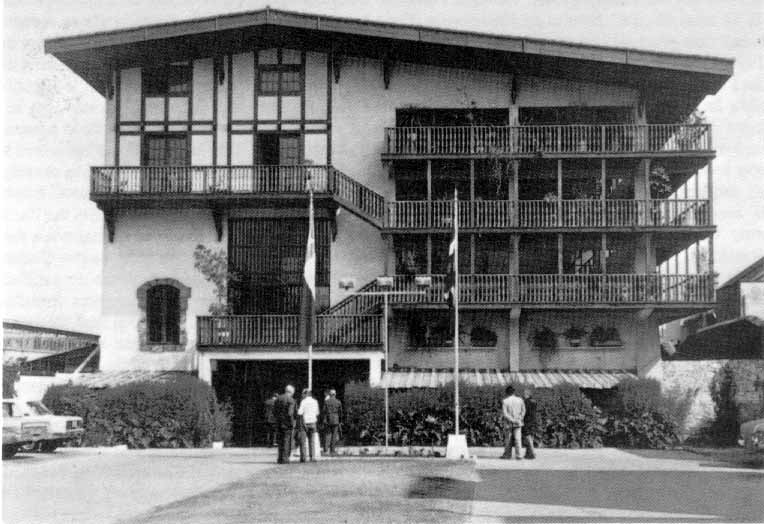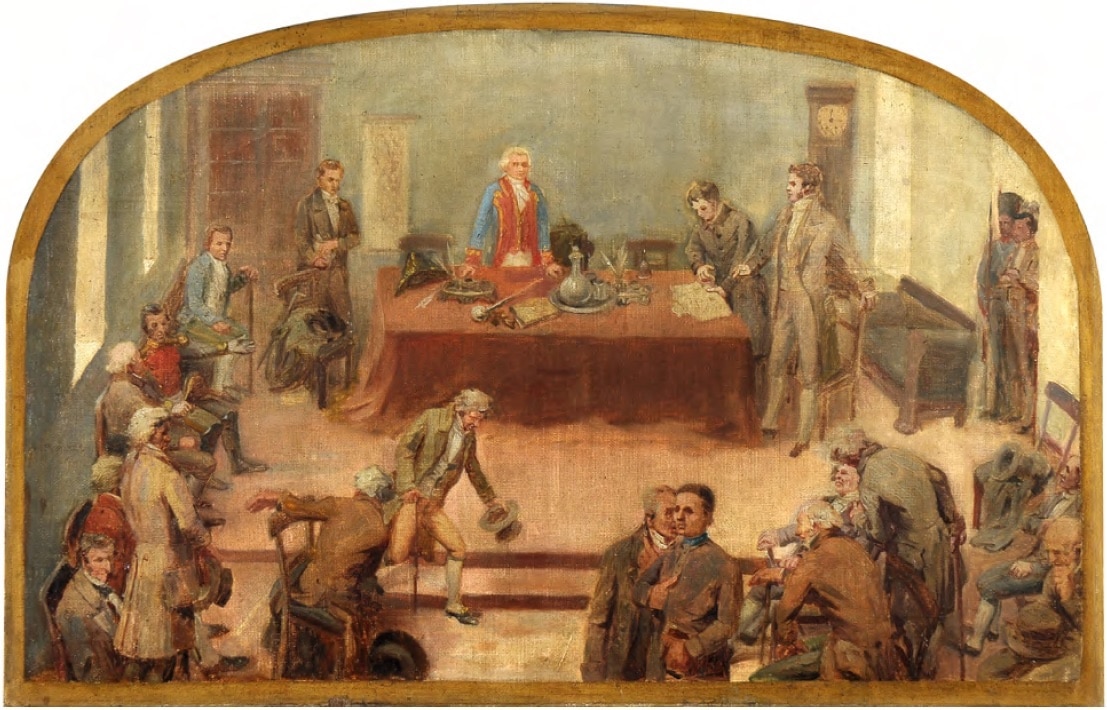This entry in our series on the bicentennial of the independence of the New World republics is dedicated to the Republic of Chile. To discuss this chapter, we’re pleased to have the collaboration of Pedro Oyanguren, a Basque-Chilean whose family’s 125 years in Chile has not worn down their connection to their original homeland in the slightest.
To see, one only needs to search his name online and find all he’s done to share “everything Basque,” including the presence and influence of the Basques in the Southern Cone. Of Chile, Miguel de Unamuno said, “Only two things of a universal nature have been done by the Basques: The creation of the Society of Jesus by Iñigo de Loyola and the Republic of Chile by the Basques.”
And as if that weren’t enough, there’s a very special connection between this Chilean Basque and our series. As we state at the end of every entry, this is a project between the Euskadi Munduan Assocaition, the Limako Arantzazu Euzko Etxea, the Brotherhood of Our Lady of Aránzazu of Lima, and the Editorial Archives of Oiga Magazine.
Well, it turns out Pedtro Oyanguren was a key figure who helped create a strategy for the members of the Brotherhood of Our Lady of Aránzazu of Lima to be able to celebrate their 400th anniversary in the best way possible, as we spoke of in an article we dedicated to remembering this special event.

At that time, he was the director of the Euzko Etxea de Santiago de Chile and his support, and through him the support of the whole Basque Center, were essential. They delivered the sapling of the Tree of Guernica that was planted to celebrate the occasion in Peru, and they delivered the Ikurriña that, alongside the flag of Peru, flew over the events that day. That Ikurriña is still in Lima, presiding over the Brotherhood and the Limako Arantzazu Euzko Etxea. And that’s just one sample, the most visible, but just one, of the support these Basques in Lima have received from the Basques in Santiago, because the support and collaboration has been much more extensive and much deeper.
After all, the Basques of the Santiago Basque Center are the natural heirs of the guild of Our Lady of Aránzazu of Santiago de Chile, which Oyanguren himself cites in his introduction. This guild was closely tied to the Brotherhood of Our Lady of Aránzazu of Lima, because, as we’ve commented on many occasions, those guilds and brotherhoods that the Basques created throughout the Americas made up a network of support an collaboration Guided by a spirit of brotherhood between the Basques, it is still alive.
So we’ll leave you with this article in our series, and two books about the Basques in Chile for which Pedro Oyanguren himself was the editor.
The first is Vascos en Chile 1520-2005. Euzko Etxea de Santiago, published in 2007 and available on the Eusko Ikaskuntza website.
The second is a part of the Urazandi Collection, which we’ve spoken of so often, and which was launched by Josu Legarreta (another “well-known” figure here on the blog). This collection dedciated its 20th volume to the Basques in Chile and the Euzko Etxea de Santiago.
Both volumes are available at the end of the article in .pdf format.
Basques and the Independence of Chile: History intertwines
Pedro Oyanguren C. – Euzko Etxea de Santiago
It’s been almost 500 years since a Basque, Sebastían Elcano, first saw the mountains and seas of a place now called Chile (1520). It would be another twenty years (1540) before the Spanish would begin exploring the area, led by Pedro de Valdivia, and the colonization of that country would begin.
This contingent contained people from Extramdura, such as Valdivia, and from other parts of the peninsula. Easily recognized by their surnames, Basques represented between 10-12%; from then on, over the centuries, they would continue to come, for several reasons. This would mark the society of the new country right from the start.
In those days, the idea of independence had never occurred to them: everything was still to be done. However, in Peru, another Basque born in Araoz, Oñati, Lope de Aguirre (1515–1561), would be the first to discuss it in his letters to King Philip II, during his trip through the Amazon in search for El Dorado. Accompanied by his soldiers, when he got to Venezuela, he died, leaving a trail of blood behind him, and quite unwittingly, his legend.
In Chile, just at the beginning of the 19th century, the first movements to break off from the kingdom began. On September 18, 1810, a date that is now commemorated as the beginning of the country’s independence, originally had a different goal. The Governor at the time, Mateo de Toro y Zambrano, called an open council meeting, in order to support Ferdinand VII, who had been forced to abidcate by Napoleon. However, the juntistas had different motives, and upon shouting, “¡Junta queremos!“, they sowed the seed of what would become their longed-for sovereignty, either years later, after many a battle.


Regarding that meeting, in addition to recognizing that it worked democratically, even supporting the king in his worst moment, what is most striking is the large number of Basque surnames among those in attendance. On that list, we find do not find any names of those who were native to those lands, so it could be conjectured that what happened afterwards was a war of independence or a civil war, if not both.
It is at this time that the Guild of Arantzazu came to an end. In research by historians Roberto Hernández and Julen Salazar, we can find several people, and we can clearly see how the histories of Chile and the Basque Country intertwine.


One example would be Pedro de Chopitea Aurrecoechea — father to Dorotea (1) and well-known member of the Santiago Guild of Arantzazu — fought on the royalist side in the Battle of Chacabuco (1817), which brought an end to Reconquest period of Chile’s history. In that battle, his commander was Rafael Maroto Isems, the same who, years later, would lead the Carlist forces in the first Carlist War, and who would sign, alongside Esparter, the “Abrazo de Vergara”, which would be the first step to bringing an end to the Basque fueros. Moroto would finally return to his hacienda in Concón, Chile, and would die in Valparaiso in 1853.
Despite having been the great loser, both in the Basque Country and in Chile, and to be considered an “enemy” of the state, in 1918, his remains were moved to the Mausoleum of the Chilean Army, as an ultimate homage…which I find very atypical, but significant nonetheless.
- Pedro Nicolás de Chopitea Aurrecoechea, first cousin to Chilean Founding Father José Miguel Carrera. His dauther Dorotea was declared Venerable by Pope John Paul II on June 9, 1983.
Libro: Vascos en Chile. Euzko Etxea de Santiago
Desde 1985 se ha ido recopilado la información disponible en Euzko Etxea de ; Santiago sobre la presencia vasca en Chile. El presente trabajo nace con el objetivo de dejar constancia del riquísimo material obtenido durante todos estos años. Para ello se realizó una minuciosa selección de los cientos de textos y artículos publicados para resumir, de una u otra forma, el origen de esta casa vasca, su historia y su aporte a la diáspora. Pinceladas a veces, aparentemente inconexas, pero su conjunto, nos da la visión de diferentes situaciones y épocas. Con estos personajes vascos y sus descendientes se llega desde la época de la Conquista, a la Colonia, la Independencia, la República y a la época actual. Son huellas seguibles que tras cuatrocientos ochenta y cinco años de historia nos dejaron los vascos en éste país.
Libro: Vascos en Chile. 1520-2005 Euzko Etxea de Santiago
La presente obra de investigación sobre la historia de la presencia vasca en Santiago de Chile, realizada por sus autores desde sendas perspectivas específicas, aporta nuevas informaciones sobre la importancia de la historia de la emigración vasca a América. En el caso específico que nos atañe, los autores nos muestran los resultados de sus investigaciones sobre los flujos emigratorios vascos a este gran país y los pasos que dieron desde el inicio para crear su propio sistema organizativo de apoyo mutuo y difusión de la cultura vasca…
The Bicentennial of the Independence of the New World Republics series is a project of the Euskadi Munduan Assocaition, the Limako Arantzazu Euzko Etxea, the Brotherhood of Our Lady of Aránzazu of Lima, and the Editorial Archives of Oiga Magazine.
Last Updated on Mar 23, 2023 by About Basque Country





























